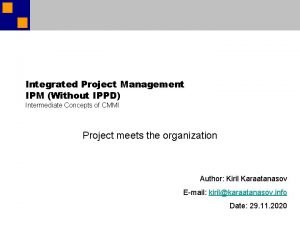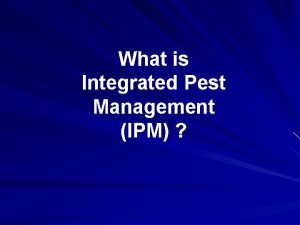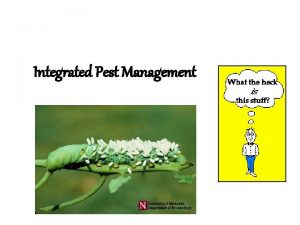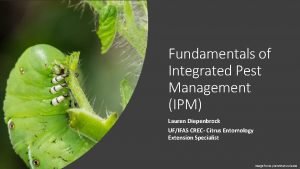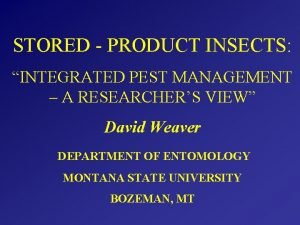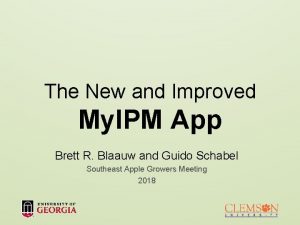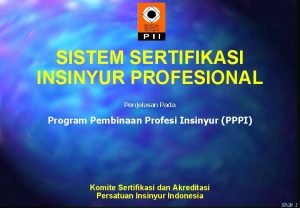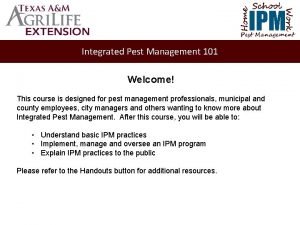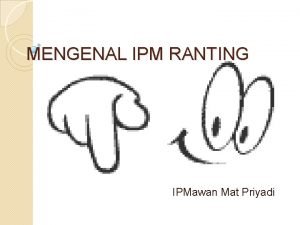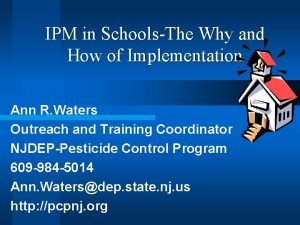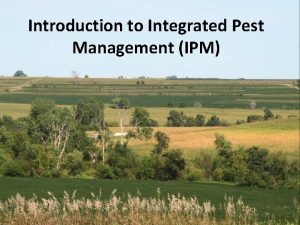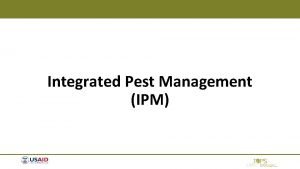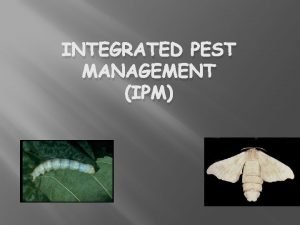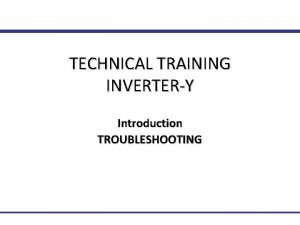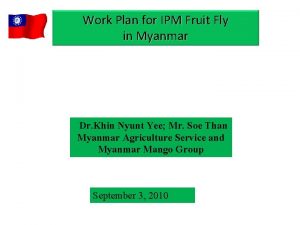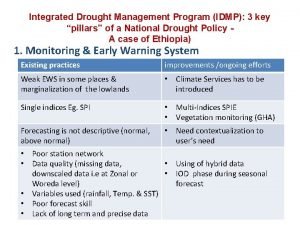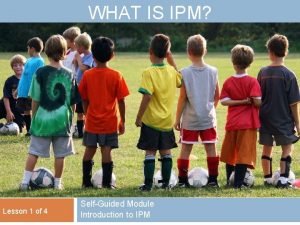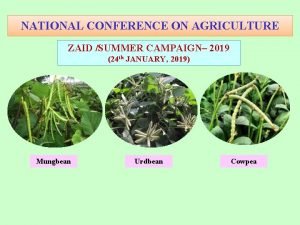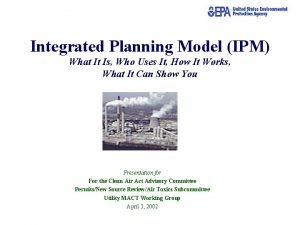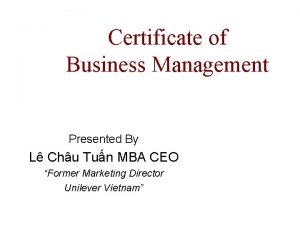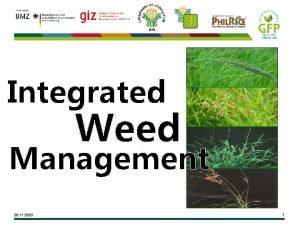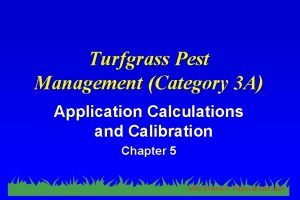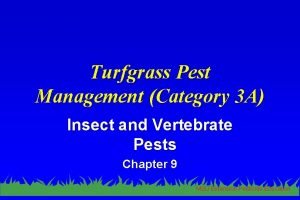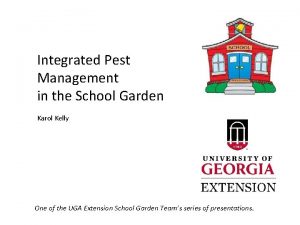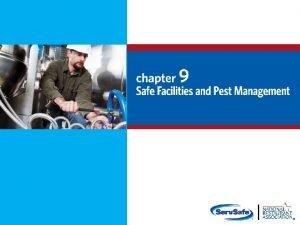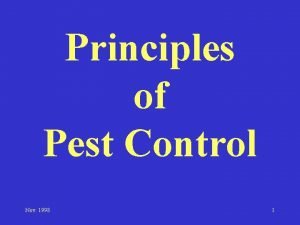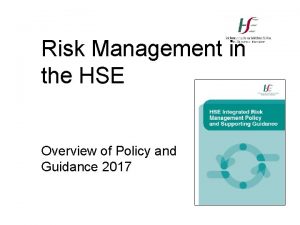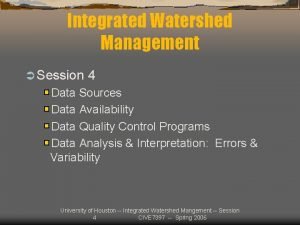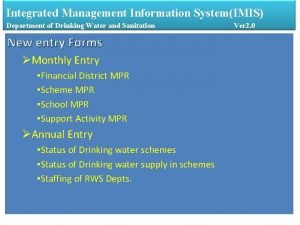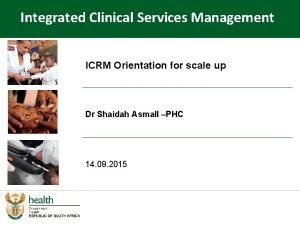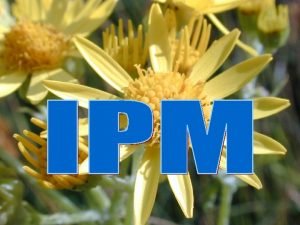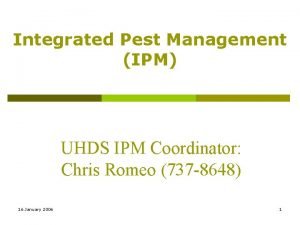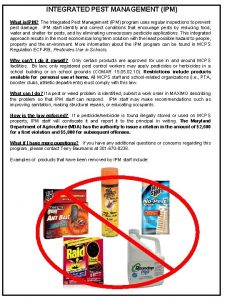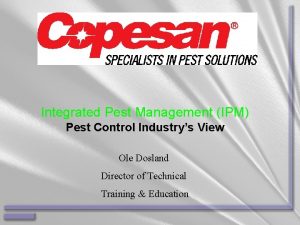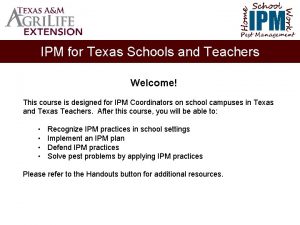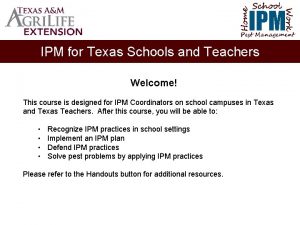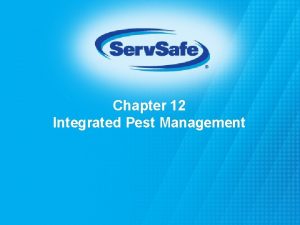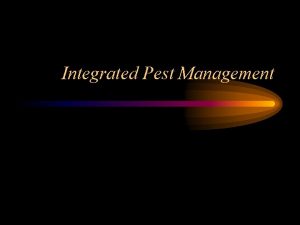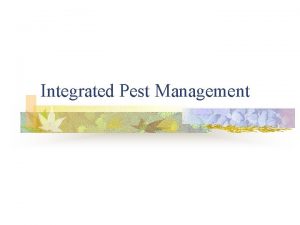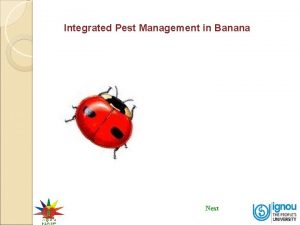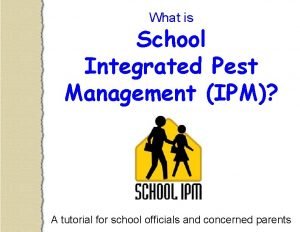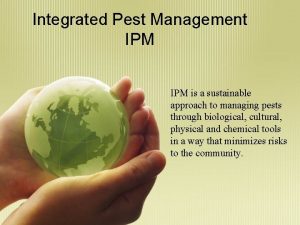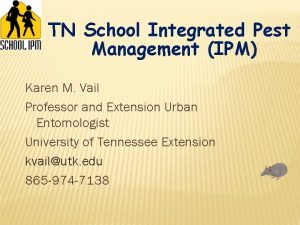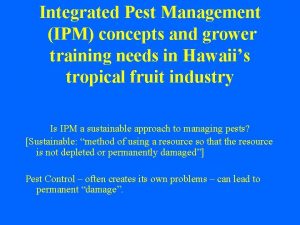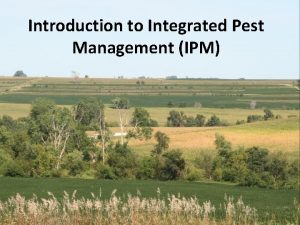Integrated Pest Management IPM Definition of Pest 1


![A Working Definition of “Pest” An injurious and noxious or troublesome living organism [that] A Working Definition of “Pest” An injurious and noxious or troublesome living organism [that]](https://slidetodoc.com/presentation_image_h2/22e6fe0a0ebb4d3ce8a7f3c1d63de0d8/image-3.jpg)









































- Slides: 44

Integrated Pest Management IPM

Definition of “Pest” (1) any organism that interferes with the activities and desires of humans or (2) any other form of terrestrial or aquatic plant or animal life or virus, bacteria, or other micro-organism (except viruses, bacteria, or other micro- organism on or in living man or other living animals) which the Administrator declares to be a pest under section 25(c)(1).
![A Working Definition of Pest An injurious and noxious or troublesome living organism that A Working Definition of “Pest” An injurious and noxious or troublesome living organism [that]](https://slidetodoc.com/presentation_image_h2/22e6fe0a0ebb4d3ce8a7f3c1d63de0d8/image-3.jpg)
A Working Definition of “Pest” An injurious and noxious or troublesome living organism [that] does not include a virus, bacteria, fungus or internal parasite that exists on humans or animals (British Columbia Pesticide Control Act, 1997) Includes insects, weeds, plant pathogens, birds, non-human mammals and other organisms which pose non-medical problems to humans and non-veterinary problems to animals

A pest must cause injury In order for an organism to be considered a pest, a damaging stage of the organism must be present in high enough numbers to cause actual injury to something valued by people.

Four things required to “make” a pest (Fig. 1 -6 from text) 1. Pest species must be present at the right stage 2. Environmental criteria must be met. 3. Crop must be a susceptible variety and growth stage. 4. All of the above must occur at the same time.

How do pests become pests? 1. New crop introductions 2. New organism introductions 3. Production system practices 4. Removal of limiting factors 5. Low tolerance

The Pest Complex • The specific collection of pest species attacking a specific commodity or cropping system at any given time and location. • A given complex is divisible into different “groups”: – Invertebrates (arthropods, molluscs) – Vertebrates (mammals, fish, birds) – Weeds (perennials, summer/winter annuals) – Plant Pathogens (fungi, bacteria, viruses, nematodes)

Each pest species has a given status within a complex • • Key pests Minor pests Secondary pests Occasional pests Potential pests Chronic pests Migrants Accessory Species – Vectors (Pest status often linked with pathogen) – Alternate Hosts

Pests are often classified by the type of injury that they cause General Terms • Direct Pests • Indirect Pests • Medical/Veterinary

Pest Injury versus Damage Injury – The effect that the pest has on the crop or commodity. Damage – The effect that injury has on man’s valuation of that crop or commodity. For crops, “Injury” is biological and “Damage” is economic. For non-crops, “Injury” = “Damage”.

Introducing “Pest Management” • “Management” -- a process by which information is collected and used to make good management decisions to reduce pest population impacts in a planned, coordinated way. • Requires: – Tolerance – Information – Strategy

IPM Defined IPM – A system that maintains the population of any pest, or pests, at or below the level that causes damage or loss, and which minimizes adverse impacts on society and environment. Attempts to balance the benefits of pest control actions with the costs when each is considered in the broadest possible terms.

Balancing costs and benefits can be done at various levels

Hypothetical Strategy Preventative Rescue Tactics

During the 19 th Century • Great strides in biological knowledge (e. g. germ theory, evolution, genetics). • Industrial revolution leads to large scale farming and commercial markets • Modern pest groups are recognized (insects, weeds, pathogens) • Potato famine creates incentive for government funding of pest controls.

19 th Century Pest Control Advances • Pressurized spray equipment nozzles invented • First modern success in biological control • First modern success in host plant resistance • Modern cultural tools developed • Most key pests’ biologies understood

• Modern pest tactics were available but only a few were practical. • Developed countries were being invaded by major foreign pests.

During the 1940’s • 1940 – DDT patented as an insecticide • 1942 – BHC found insecticidal • 1943 – 2, 4 -D found effective as a herbicide • 1946 – Gerhard Schrader hired by Bayer • 1946 – Houseflies found resistant to DDT

During 1950’s Organic chemical pesticides become routine on all crops • Viewed as “modern” farming • Low risk, “cost of business” • Few/no regulations

Problems Arising During the 1950’s • Pest Resistance • Bird/Fish Kills • Human Poisonings • Secondary Pests • Biomagnification

“Pesticide Treadmill” 1. Spray, kill pest & natural controls. Pest comes back. Repeat until… 2. Resistance in primary pest. Increase application rates. Kill broader range of natural controls. 3. Induce secondary pest 4. Begin spraying for secondary pest until… 5. Resistance in secondary pest 6. Change chemicals. Repeat sequence.

Current Status • IPM widely recognized as the proper approach to dealing with pests in production agriculture. • Implementation is up to individual farmers so it varies considerably • Concepts are well established but the technology continues to improve.

Impact Related to Direct & Indirect Effects Comparison of Direct and Indirect Pests Characteristic Direct Indirect Commodity Yield-Pest Relationship Marketable Non-Marketable Simple Complex Pest Status Usually Key Pest Any Pest Group Insects & Pathogens Any Farmer Tolerance Low Higher

General Impact of Pests -- Injury • • Consumption of plant parts Chemical toxins, elicitors, and signals Physical damage Loss of harvest quality Cosmetic damage Vectoring of pathogens Direct contamination

General Impact of Pests – Noninjury • Costs incurred to implement controls • Environmental and social costs • Regulatory costs (embargoes, quarantines, shipment costs, etc. )

Tissue Injury to Leaves Abscission -- Leaf prematurely dropped by the plant, often while still green.

Tissue Injury to Leaves Bleaching Leaf turns white or nearly so. Usually caused by using the wrong herbicide.

Tissue Injury to Leaves Chlorosis Leaf tissue loses its chlorophyll and turns yellow. May occur in spots. Chlorosis in soybeans. Individual leaves (left) and at the field level (right).

Tissue Injury to Leaves Crinkling Leaf takes on a crinkled texture. Usually associated with viruses or toxic effects of saliva from homopterous insects. Crinkling may occur throughout the leaf (left) or may be confined to edges (right).

Tissue Injury to Leaves Cupping and Curling Leaves cup up or down or they curl inward from the edges. Downward cupping along main vein of each leaflet in soybeans caused by Bean Common Mosaic Potyvirus

Tissue Injury to Leaves Edge Feeding Leaves chewed and eaten from the edges. Feeding lesions can have smooth or jagged edges. Usually caused by insects w/chewing mouthparts. Leaf edge feeding on rhododendron leaves by adult black vine root weevils.

Tissue Injury to Leaves Hole Feeding Leaves have holes chewed through them. Caused by insects w/chewing mouthparts. Yellow poplar weevil adult feeding on yellow poplar

Tissue Injury to Leaves Mines Caused by small, immature beetles or flies that live in-between the upper and lower leaf surfaces. The shape of the mine, along with the plant species being attacked, is useful in identifying the pest species involved. Frass-linear leaf mine on birch leaf. Mines come in many shapes.

Tissue Injury to Leaves Mottling Leaf is not uniform in color but is, instead, a mottled mixture of different shades of green to yellow. Soybean leaf mottling caused by the Bean Pod Mottle Virus.

Tissue Injury to Leaves Necrosis Areas of dead tissue which usually sloughs off over time. Necrosis simply means dead tissue and may occur in any pattern. Necrosis may be in spots (top left), on leaf margins (above), or follow leaf veins (bottom left). Other patterns are possible as well.

Tissue Injury to Leaves Rolling Leaf is rolled up like a cigar. Usually caused by caterpillars that use the rolled leaf as a pupation chamber. Leaves may be rolled entirely (above) or only partially (left).

Tissue Injury to Leaves Shothole Small holes in a straight line across the leaf. Usually caused by insects that bore through the developing leaf when the un-emerged leaf is still rolled up in the plant’s whorl.

Tissue Injury to Leaves Skeletonization Leaf tissue between the veins is removed but the veins remain intact leaving a skeleton-like appearance. Lindin leaf skeletonized by Japanese beetle. Note that the distal leaf tissue is relatively normal looking indicating that the leaf veins are fully functional.

Tissue Injury to Leaves Spots Caused by fungal, bacterial, and viral diseases. Spots vary in size, shape and number and may be solid or only peripheral (e. g. ring spot, frog-eye spot). Fungal leaf spot on soybean Bacterial leaf spot on pepper Viral ring spot on purple cone flower

Tissue Injury to Leaves Stippling Large numbers of tiny pin-prick feeding lesions cause by mites or other minute herbivores with piercing-sucking mouthparts. Leaf stippling by leaf hoppers (sucking insect). Non-uniform pattern. Stippling = dead cells surrounding feeding puncture.

Tissue Injury to Leaves Windowpaning One side of the leaf is scrapped off leaving the other side intact and translucent. This gives the feeding lesion a window-like appearance. Primarily caused by some young beetle and moth larvae. Cereal leaf beetle windowpaning on wheat (left); European corn borer windowpaning on corn (right).

Structural Tissue Injury • Galls (may be on any tissue) • Interference with transport – Xylem injury – Phloem injury • Interference with structural support • Shape/appearance impact – Abnormal growth – Shoot dieback

Galls Can occur on all tissues; leaves, stems/trunks, branches, roots, etc. Ash flower galls caused by a mite Olive knot gall (caused by Pseudmomonas bacteria) on olive main trunk Galls on oak leaves from cynipid wasps Western gall rust on Ponderosa pine branch Soybean roots with galls from root knot nematode (right) vs. healthy root (left).

Structural Tissue Injury -- Xylem Many insects, such as the squash vine borer feed on xylem tissue. Tomato wilt is caused by fungi in the genus Fusarium which plugs xylem tissue preventing water/mineral transport.
 Integrated project management definition
Integrated project management definition Objectives of integrated pest management
Objectives of integrated pest management Integrated pest management
Integrated pest management Ipm
Ipm Integrated pest management ____ than pesticides.
Integrated pest management ____ than pesticides. What is the third step in integrated pest management?
What is the third step in integrated pest management? My ipm
My ipm Sertifikat insinyur profesional
Sertifikat insinyur profesional Ipm
Ipm Ipm adalah
Ipm adalah What is an ipm plan
What is an ipm plan Ipm meaning
Ipm meaning Ipm
Ipm Ipm plants
Ipm plants O'general ac error code list
O'general ac error code list Ipm myanmar
Ipm myanmar Pillars of ipm
Pillars of ipm Ipm grade 1
Ipm grade 1 Ipm indeks pembangunan manusia
Ipm indeks pembangunan manusia Ipm 410-3 (shikha) price
Ipm 410-3 (shikha) price Ipm model
Ipm model Pipe onion
Pipe onion Ipm tuyển dụng
Ipm tuyển dụng Integrated weed management definition
Integrated weed management definition Turfgrass pest management (category 3a practice test)
Turfgrass pest management (category 3a practice test) Electric dhaver
Electric dhaver Turfgrass pest management
Turfgrass pest management Georgia pest management handbook
Georgia pest management handbook Safe facilities and pest management
Safe facilities and pest management P e s t
P e s t Pest scouting definition
Pest scouting definition Integrated logistics management
Integrated logistics management Integrated logistics management
Integrated logistics management Risk management policy hse
Risk management policy hse Integrated watershed management
Integrated watershed management Objective of university management system
Objective of university management system Integrated talent management scorecards
Integrated talent management scorecards Ism integrated service management
Ism integrated service management Pas 99
Pas 99 Enterprise wide quality integrated management solution
Enterprise wide quality integrated management solution Integrated education management system
Integrated education management system Power management integrated circuits
Power management integrated circuits Integrated management information system imis
Integrated management information system imis Integrated clinical services management
Integrated clinical services management Advertising and integrated brand promotion 8th edition
Advertising and integrated brand promotion 8th edition
